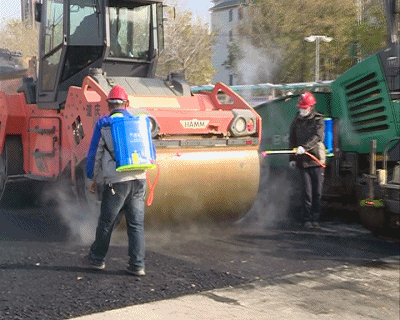Application of composite anti icing and snow melting additives in the construction of freeways with self melting and non icing after snow
Hebei Province has highways that melt and do not freeze after snow
Recently, the experimental section of the project "Research and Promotion of Self melting Snow and Deicing Technology for Asphalt Pavement on Freeways" undertaken by Hebei Provincial Transportation Planning and Design Institute was successfully paved on the left side of the Laiqu section of the Taihang Mountain Expressway from K25+960 to K28+460. Since then, Hebei Province has developed highways that melt after snow and do not freeze.
The experimental section uses a series of environmentally friendly road surface additives independently developed by the Provincial Transportation Planning and Design Institute to replace some or all of the mineral powder in the asphalt mixture. It does not change the normal construction process or increase the construction difficulty. Under the condition of not affecting the technical indicators of the mixture and the performance of the road surface, and not polluting the environment, it achieves self melting of road snowfall and suppresses road icing, which can effectively improve the driving safety and traffic efficiency of highways in winter rainy and snowy weather.
Principle of self melting snow and ice removal technology for asphalt pavement
The main mechanism of self melting snow and ice removal technology for asphalt pavement is to add special snow melting materials to the asphalt mixture to replace mineral powder and other fillers for the upper layer of asphalt pavement. Under the conditions of low winter temperature and increased air humidity, the snow melting materials are activated and continuously precipitated through the pumping, capillary action, and friction of driving vehicles. After contact with snowfall, a low freezing point liquid isolation layer is formed to play the role of snow melting, and effectively prevent the adhesion between the ice layer and the pavement.
What is the scope of application of self melting snow and ice removal technology for asphalt pavement?
Self melting snow and de icing asphalt pavement can be laid on steep slope sections, tunnel entrances and exits, bridge decks, and shaded and curved sections of mountainous highways. It can also be laid on intersection areas of urban roads to prevent vehicles from braking and slipping on snowy days. When replacing mineral powder in asphalt mixture with a 5% dosage, the winter freezing temperature of asphalt pavement can be reduced to -5 ℃~-40 ℃. During the transition period between autumn and winter and early spring, it can also prevent the formation of "black ice" and "dark ice" on the pavement, providing a guarantee for driving safety.
What are the advantages of self melting snow and ice removal technology for asphalt pavement?
The self melting snow and ice removal technology of asphalt pavement changes the snow removal from passive to active, ensuring timely snow removal. It can reduce the amount and frequency of snow melting agent application, thereby reducing the harm of salt compounds in ordinary snow melting agents to road structures and the environment. At the same time, it reduces the difficulty of winter snow removal, saves snow removal time, and significantly reduces the cost of winter snow removal.
Self melting snow and ice removal technology is currently the most advanced active ice suppression technology for asphalt pavements widely used internationally. After years of research and development and technical accumulation, the Provincial Transportation Planning and Design Institute has developed a series of easy melting ice products. The self melting snow and ice removal test section of the Laiqu section of the Taihang Mountain Expressway is the first application of the product, and its successful paving has accumulated valuable experience for the further large-scale promotion and application of self melting snow and ice removal technology for asphalt pavement in the province.
Jinyang Street Bridge Lane: A New Expressway with Snow and Ice Melting Prevention Function
The Hunnan Avenue Expressway Project has a total length of 10.7 kilometers. From Shengli Street to Wenhui Street east of Changqing Street, six node projects will be constructed from west to east along the route, including Shengli Street Interchange, Hunnan Avenue Bridge over Nanjing Street, and Hunnan Avenue Bridge over Jinyang Street.
The Jinyang Street Node Bridge spans Jinyang Street from west to east, and the expressway with new snow and ice melting functions is the three rows of lanes on the south side of Jinyang Street Bridge, totaling 640 meters long and 11.02 meters wide. From the scene, there is no difference between the asphalt concrete pavement being laid and the ordinary asphalt concrete pavement, but there are many things mentioned inside. First of all, these workers are spraying things on the roller in their hands.
Application of Composite Anti icing and Snow Melting Additives in the Construction of Freeways with Self melting and Non icing after Snow

Secondly, there is this new type of material, called high-performance composite anti icing and snow melting additive, which is added to the formula of asphalt pavement. With this special additive, this section of the expressway is like wearing a "warm baby". With this "warm baby", the safety factor of driving under ice and snow conditions will be greatly improved.
You don't have to worry, this anti icing and snow melting additive won't cause damage to the main structure of roads and bridges, as well as the surrounding vegetation, soil, and water sources. Moreover, the service life of asphalt concrete pavement with the addition of this additive is no different from that of ordinary asphalt concrete.
It won't freeze at temperatures above minus 15 degrees Celsius, which is definitely a safe thing for drivers. However, why is this new technology only applied to this section of the expressway?
The reason for choosing to conduct the experiment on the node bridge of Jinyang Street is that compared to ordinary road surfaces, the traffic flow on the elevated bridge is relatively high, and the danger of driving on winter ice and snow roads is higher.
Application of Composite Anti icing and Snow Melting Additives in the Construction of Freeways with Self melting and Non icing after Snow

After the completion of this special layer of asphalt concrete paving, the Jinyang Street node bridge will carry out subsequent projects such as pavement expansion joint installation and traffic marking. It is expected that the node project of Jinyang Street will have the conditions for opening to traffic by the end of the year. This expressway will also become the first non freezing expressway in Shenyang.
The first non icing expressway in China - the first section of Beijing New Airport Expressway with asphalt pavement
On April 30, 2019, the first section of the road surface layer of Beijing Daxing International Airport Expressway began to be paved with asphalt. Beijing Youth Daily reporter learned from the construction company Beijing Municipal Road and Bridge Group that due to the addition of anti icing and snow melting materials in asphalt, the new airport expressway will become the first expressway in China with anti icing and snow melting functions.
At the construction site of the New Airport Expressway located north of Weiyong Road in Daxing District, more than ten road rollers are operating simultaneously and paving asphalt concrete in an orderly manner. It is reported that the first section of the road will be paved with 1.5 kilometers of surface asphalt, approximately 2500 tons, throughout the day. The person in charge of the general contracting department of Beijing Municipal Road and Bridge Group, responsible for asphalt pavement, introduced that in order to achieve anti icing and snow melting performance on the new airport highway, technical personnel have added three high-performance composite anti icing and snow melting additives to the original advanced asphalt pavement formula. This way, in weather above minus 12 degrees Celsius, the pavement with "anti icing and snow melting" function will not freeze, effectively avoiding the formation of "ground penetrating armor" on the pavement in northern autumn and winter, and reducing the management and maintenance costs of the pavement in areas such as ice and snow removal. In addition, anti icing and snow melting additives will not cause damage to the main structure of roads and bridges, as well as the surrounding vegetation, soil, and water sources.
It is reported that the asphalt paving on the surface layer will be the final layer of asphalt on the new airport expressway pavement. It is expected that by the end of May, the 27 kilometer long new airport expressway will complete the paving of asphalt on the road surface. After the completion of asphalt pavement on the surface layer, subsequent projects such as road marking and lamp post installation will be carried out.
Note: All accompanying images in the article are reposted online. Any infringement will result in deletion!


